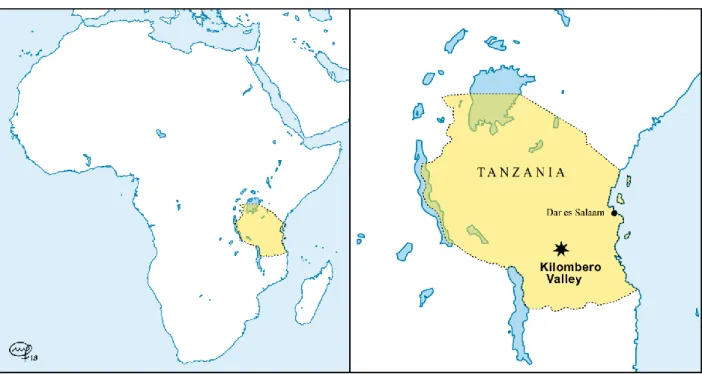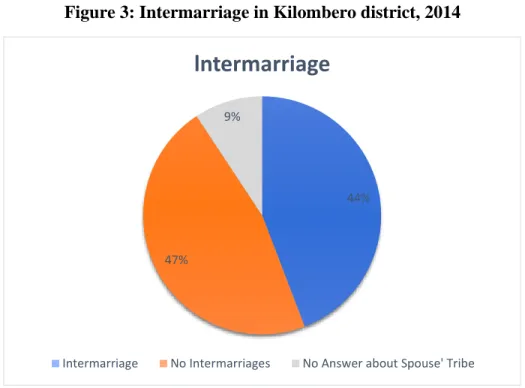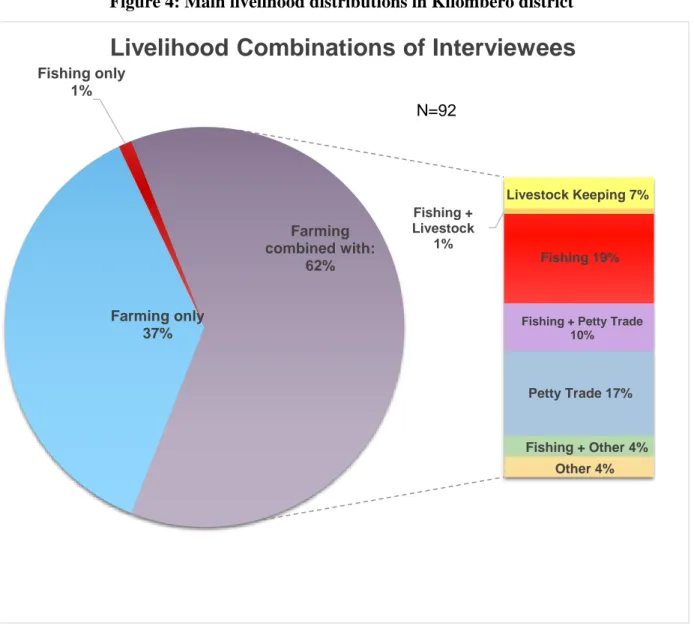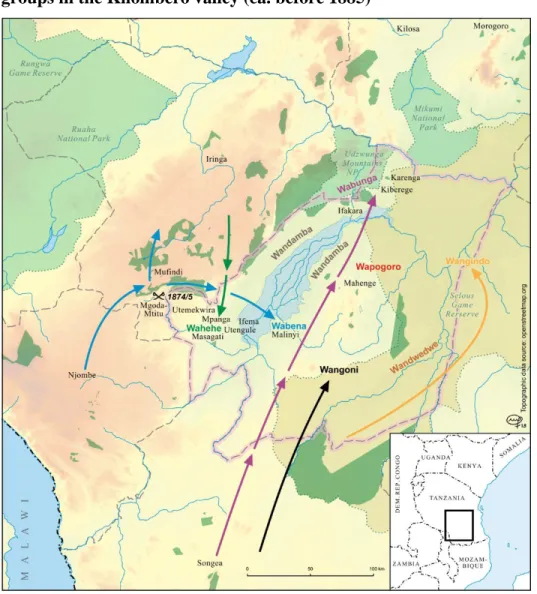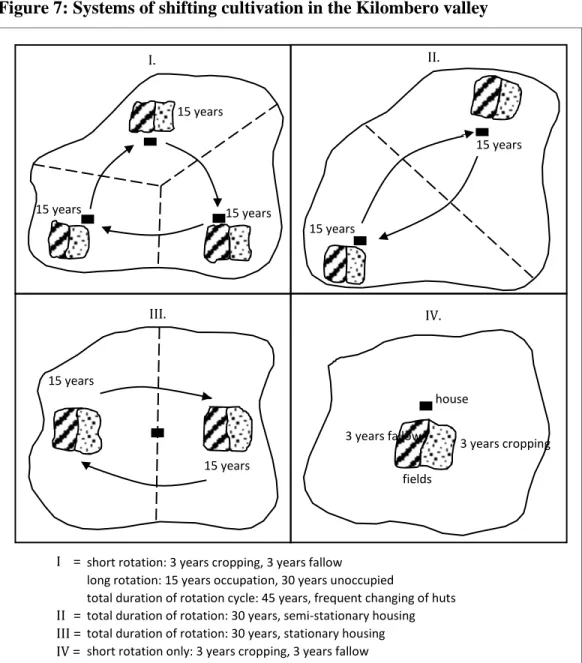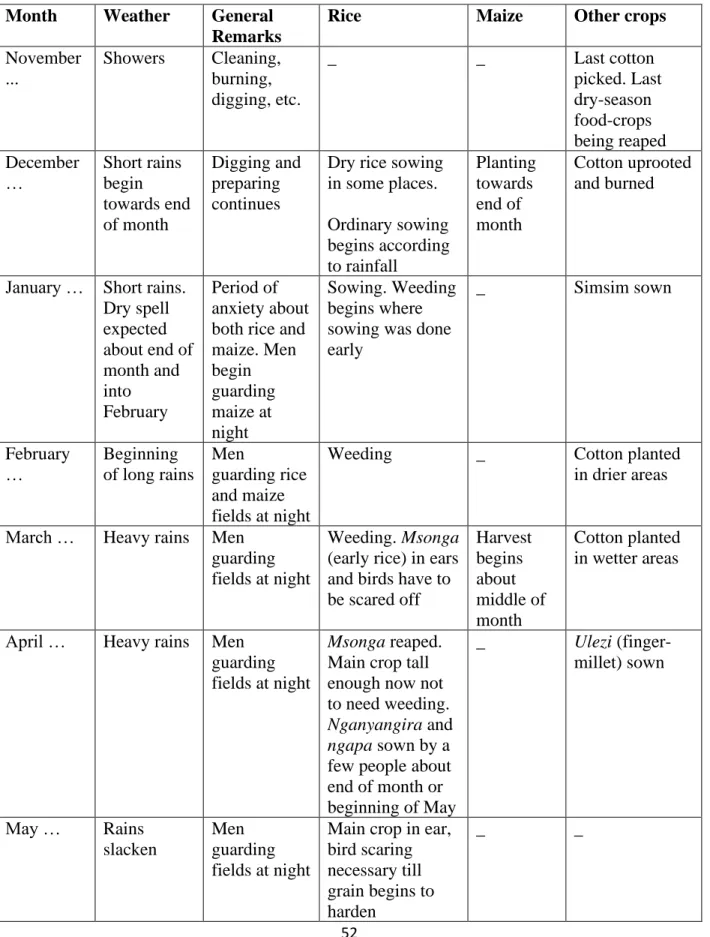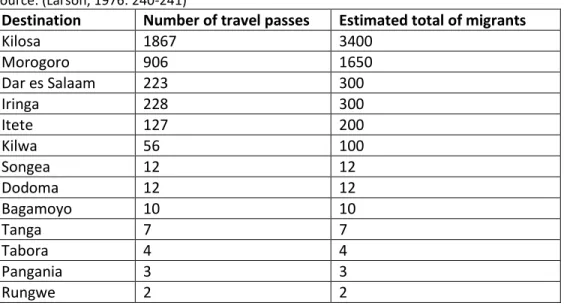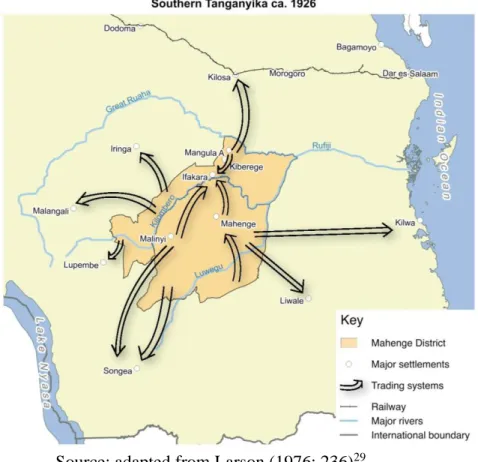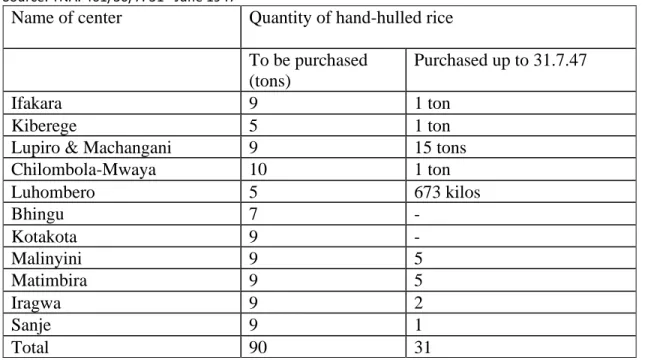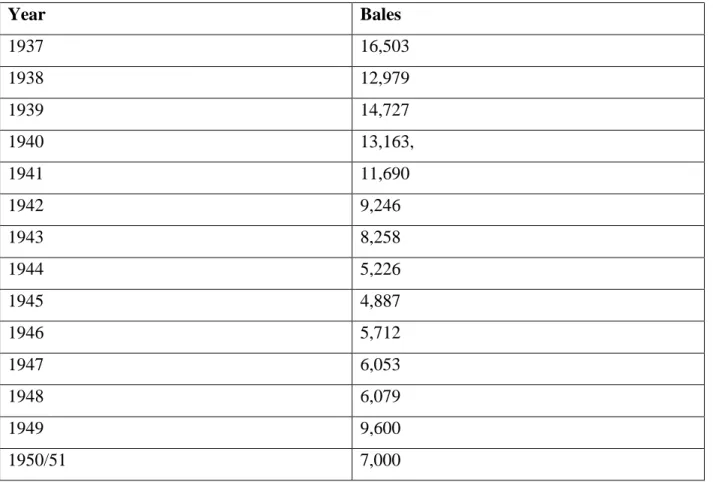Agricultural improvement? Persistence and change in agricultural development ideas and farmers’ responses in Kilombero Valley, Tanzania
(1900-2015)
This dissertation was
accepted for the completion of the doctorate from the Faculty of Arts and Humanities
of the University of Cologne
in the subject, Social and Cultural Anthropology
Innocent Mwaka
born on 30.12.1983 in Lacor Gulu, Uganda
Cologne, December 2020
i
Declaration
I solemnly declare that I prepared the dissertation I am presenting independently and without undue
assistance, that I have completely stated the sources and aids used, and that in each individual case
I have identified the passages in the dissertation, including tables, maps and images, that are quoted
from other works literally or in spirit as a borrowing; that this dissertation has not been presented
to any other faculty or university for examination; that it has not yet been published, apart possibly
from partial publication approved by the chairperson of the doctoral committee after consultation
with the supervising professor, as well as that I will not undertake any such publication before
completing the doctorate. I am aware of the provisions in Sect. 20 and 21 of the doctoral
regulations. The dissertation I am presenting has been supervised by Prof. Dr. Michael Bollig.
ii
Abstract
The Kilombero valley in south-central Tanzania has undergone a series of agricultural development experiments since German colonialism. These experiments have largely failed to meet their goals of increasing production and quality of agricultural products. However, experiments similar to earlier ventures are still being implemented in the valley today under the auspices of the Southern Agricultural Growth Corridor of Tanzania (SAGCOT). This raises one central question: why, despite the failures of earlier strategies, have similar recipes for agricultural development persisted in the valley? I approach this question by analyzing the discourses and practices of agricultural development in the valley since the German colonial time.
Following the footsteps of post-developmentalists like Ferguson (1990) and Li (2005) I ask what these agricultural development strategies have done in the valley such that they are replicated over time. A focus on discourses and policies allows conceiving agricultural development projects as having certain effects, which give their strategies persistence.
I furthermore investigate how the recipients of the agricultural development projects in the valley perceive such initiatives and how they respond to them. Previous research in the valley (e.g.
Monson, 1995) and research elsewhere on development topics (see for instance Li, 2005;
Venkatesan and Yarrow, 2014) have shown that people either resist or comply with such initiatives.
However, it is necessary to examine the nature and effects of such responses as well. For if recipients “resist” a development project, what is the nature of such resistance? Does it lead to modifying the development strategy? Does it intensify it, or lead to a complete overhaul? And if recipients comply, how does compliance affect policy and practice?
I, therefore, analyze the history of agricultural development in the valley, considering
colonial and post-colonial policies and the diverse actors that attempted to improve its agricultural
production. In so doing, I examine the consequences of these policies and the outcomes of different
actions in shaping the agricultural development landscape in the valley. However, considering the
state of agriculture in the valley, this book can be read in two ways: on the one hand, as an
exploration of the history of agricultural development in Kilombero Valley and on the other, as a
critique of the development experiments that continue to reappear in new forms.
iii
Acknowledgements
The process of writing a PhD dissertation requires a lot of effort, time, and patience from the candidate, “academic elders”, peers, and most importantly family. Beyond this enclave of professional, social and family support are the people of whom the work speaks and with whom we collaborate. Without all this support, this work would not have materialized. It is therefore with humility, that I want to extend my gratitude to all who made this work possible. I cannot however place a weight to their contributions in relation to others.
I will start by thanking my wife for the patience and support she gave me from the start of my PhD to the end. The numerous discussions we had on the topic of agricultural development were instructive. The time she took off from work to take care of our little baby so that I could work longer hours meant a lot to me. She always offered encouraging words and support whenever I felt like I had reached a dead end. I extend, as well, my gratitude to all those who supported us in this period, especially my in-laws.
My academic journey and interest in anthropology started when I met Prof. Dr. Lioba Lenhart in 2008. By then a visiting scholar and guest lecturer at the Institute of Peace and Conflict Studies at Gulu University, Uganda, Lioba introduced me to different perspectives in anthropology.
Not only did I discover the honesty in anthropological methods, I admired the perspectives expressed in the self-criticism of the discipline. Lioba supported this interest by pointing me towards different opportunities and fully supporting me in achieving them.
In October 2010, I started my studies in an MA in Culture and Environment in Africa (CEA) class at the University of Cologne. It was within these studies that I developed interests in studying
“development” in Africa. Towards the end of my CEA studies, I met Dr. Clemens Greiner who introduced me to studies and literature on agrarian development and guided me in my research on honey production in East Pokot. Clemens continued to guide and mentor me in my PhD studies. I am grateful for both the slithering critics and encouraging words during the period of conceptualizing my research topic and writing the dissertation.
I would like to extend my sincere gratitude to my supervisor Prof. Dr. Michael Bollig. Since my MA studies, I have benefited from the knowledge, comments and support from Michael.
Despite his busy schedule, he always had time not only for me but all his students. He has brought
to knowledge what different opportunities there are and supported us in archiving them. The
support I got from Clemens and Michael go beyond their constructive comments towards my
iv
dissertation to other activities e.g. funding for conferences, workshops, flights to job interviews e.t.c. I would like to further thank my second and third supervisors Prof. Dr. Julia Tischler and Prof. Dr. Martin Zillinger for their critical reviews on approach and content of my dissertation.
I would like to thank my peers, Matian van Soest, Johanna Treidl, Elsemi Olwage, Souleymane Diallo, Gerda Kuiper, Diego Menestrey, Marie Mueller, Marie Gravesen, Denis Akena, Qian Zhu, Eric Kioko, Hauke-Peter Vehrs, and Cora Gäbel who, not only endured the pain of reading draft chapters and discussing them with me, but joined for a beer, a coffee or a dinner to make the PhD writing less distressing.
This PhD was funded by the BMBF through the GlobE wetlands in East Africa project. The funding made it possible to join the University of Cologne, and carry out long field works, and sustain myself and family for 3.5 years. I further received a 3-month completion grant from DAAD through the STIBET program of the International Office at the University of Cologne. I am grateful for their support especially in ensuring that international students in German universities get a comfortable stay so that we concentrate on our studies and research.
Last but not least, I would like to humbly thank the people I worked with while in Kilombero and those who helped in organizing the data when I came back to Germany from fieldwork. The numerous respondents, and their personal stories, materials, and time were invaluable for this work. Those who helped me to settle in Kilombero, to find people to talk to, to translate, to transcribe and many more, I am very grateful. In this regard, I would like to send special thanks to Anne-Christina, Elias Shemtoi, Mbilinyi, Geofrey Isdory, Veronika Steffens, and Daniel Malto. I am grateful to all of you.
I owe the success of this work to all those mentioned above and all who contributed in
different ways. I take up the sole responsibility for any shortcomings of the dissertation.
v
Dedication
To my mother Janet Mary Lukwiya who endeavored to educate not only her children but the
village.
vi
Declaration... i
Abstract... ii
Acknowledgements... iii
Dedication... v
Table of contents... vi
List of tables... ix
List of figures... ix
List of photographs... x
List of abbreviations... xi
Table of Contents 1 Introduction ... 1
1.1 Agricultural improvement? Background, scope and research questions... 1
1.2 Smallholders and the agricultural improvement strategies in the Kilombero valley... 6
1.2.1 Groupings – cooperative societies and village settlements ... 7
1.2.2 Intensification and use of modern technology ... 8
1.2.3 Engaging smallholder farmers in commercial value chains ... 9
1.2.4 Large-scale farming... 10
1.2.5 Conservation of the soil, flora and fauna ... 11
1.3 Studying persistence in agricultural development in the valley ... 12
1.3.1 Discursive practices ... 12
1.3.2 Beyond discourse: agency and practice ... 15
1.4 Outline of the dissertation... 16
1.5 The setting: into the Kilombero valley ... 18
2 The unfolding anthropological methods ... 25
2.1 Unfolding methods ... 26
2.1.1 Social survey and case study ... 26
2.1.2 Narratives ... 32
2.1.3 Life history ... 33
2.1.4 Researching archival records ... 35
2.2 End and continuities of “field work” ... 40
3 Changing practices and agricultural improvement in Kilombero valley before 1940 ... 42
3.1 Migrations and agricultural practices in pre- and early colonial periods in the valley ... 42
3.1.1 Valley inhabitants: migration and identity in the Kilombero valley (1850-1920) ... 42
vii
3.1.2 Agricultural systems in the Kilombero valley before 1940 ... 45
3.2 Reorganization of local institutions and agricultural production ... 55
3.2.1 Political and administrative reorganization ... 55
3.2.2 Socio-economic reorganization ... 59
3.3 A valley reorganized. What next? ... 74
4 Paddy and cotton improvement? Market monopoly, production control and the uncaptured peasantry: 1940-1961 ... 76
4.1 British colonial agricultural policies and schemes in Tanganyika: 1940 – 1960 ... 76
4.2 Paddy and cotton production and control in the valley: 1940 – 1960 ... 78
4.2.1 Paddy and rice control: 1943-1960... 78
4.2.2 Cotton control: 1940-1961 ... 89
4.3 Connections: paddy and cotton ... 94
5 Post-colonial agriculture in Kilombero: A nationalist vision, global shadows or a colonial mirror? 1960-1980 ... 96
5.1 Framing Tanzania’s post-colonial agricultural policies within global and colonial development trajectories ... 97
5.2 Nothing learned, nothing forgotten in Kilombero valley ... 103
5.2.1 Cooperatives, settlements and villages in Kilombero ... 103
5.3 A concluding remark ... 119
6 Cooperative societies and agricultural improvement: 1980 - 2015 ... 121
6.1 The evolution of cooperative society frameworks in Tanzania: 1980 and 2015 ... 122
6.2 Remembering cooperatives in Kilombero district ... 126
6.3 Organization and functioning of cooperative societies in Kilombero after 2009 ... 130
6.3.1 Levels of participation ... 132
6.3.2 Levels of input use ... 136
6.3.3 Output/quantity of production ... 139
6.4 The progressive cooperatives: two case studies ... 140
6.5 Have cooperatives in the valley met their expectations? ... 143
7 Standardization, markets and agricultural improvement since 2008 ... 147
7.1 A renewed interest in value chain and standards in the Kilombero valley ... 147
7.2 Working with the concepts of value chains and standards ... 149
7.3 Ntalamu and his milling machine: a biography of a Kilombero rice miller ... 150
7.4 Transaction dynamics and the value chain standards in Kilombero district ... 152
7.4.1 Input stage: smallholder farmers and adoption of farm standards in Kilombero .... 152
viii
7.4.2 Post-harvest trade stage: smallholder farmers, middlemen and selling paddy ... 159
7.4.3 Milling and marketing stage: middlemen, millers, and traders ... 160
7.5 Winners and losers in the value chain: Positioning benefits for smallholder farmers in Kilombero ... 163
7.6 Inclusion and exclusion of Kilombero smallholder farmers in the value chain: final thoughts ... 168
8 Contested areas, evictions and agricultural improvement? ... 171
8.1 Political discourses and public validations – narratives and policy actions in the valley . 171 8.2 Agro-pastoral conflicts in the Kilombero valley – myths and realities ... 177
8.3 Land, water, and enclosures in the valley: a brief overview ... 185
8.3.1 Ramsar site and contested spaces... 190
8.3.2 SAGCOT, largescale farming and contested spaces ... 193
8.4 What futures? – a concluding remark ... 201
9 Finding connections and linkages: a conclusion ... 203
9.1 The discursive practices of agricultural improvement in Kilombero valley ... 204
9.1.1 Groupings – cooperative societies, villages and settlements ... 204
9.1.2 Intensification and use of modern technology ... 206
9.1.3 Engaging smallholder farmers in commercial value chains ... 207
9.1.4 Large-scale farming... 209
9.1.5 Conservation ... 210
9.2 Synergies... 211
References ... 214
ix
List of tables
Table 1: The agricultural year in Kilombero valley, 1930s ... 52
Table 2: Labor migration out of Mahenge district, 1926 ... 62
Table 3: Settlements and their respective tax paying ... 68
Table 4: Market posts in Kilombero valley, 1943 ... 81
Table 5: Anticipated and actual purchase of hand-hulled rice at different market posts in Ulanga district by D.K Hindocha (Tang) Limited, 1947 ... 88
Table 6: Quantity of paddy sold in Ulanga district between 1949 – 1957 ... 89
Table 7: Production of native-grown cotton lint in the Eastern Province (in bales of 400lb) ... 90
Table 8: Summary of Government agricultural policies in mainland Tanzania, 1946-76 ... 100
Table 9: Changes in number of members in 12 cooperative societies ... 131
Table 10: Use of extension services between 2005 and 2014 ... 157
Table 11: Quantity of paddy produced and sold for the year 2013 ... 158
Table 12: Report B. Q51. Do you sell your crops? Where N=94 ... 159
Table 13: Quantity of paddy brought and milled in Ntalamu's rice mill for seasons 2013-2014 and 2014-2015 ... 164
Table 14: Timeline over evictions in Operation Save Kilombero Valley, 2010-2013 ... 176
Table 15: Number of livestock branded in Kilombero district between August and October 2012 179 Table 16: List of farms in Kilombero district council owned by corporate farmers, 2015... 195
Table 17: List of medium-scale farmers in Kilombero district council, 2015 ... 196
List of figures
Figure 1: Map of Africa and of Tanzania showing the location of Kilombero valley ... 1Figure 2: Map showing Kilombero valley with some of its land use activities ... 19
Figure 3: Intermarriage in Kilombero district, 2014 ... 23
Figure 4: Main livelihood distributions in Kilombero district ... 24
Figure 5: Map of Kilombero valley showing the location of Mahutanga village ... 30
Figure 6: Map showing migration and settlement patterns of different groups in the Kilombero valley (ca. before 1885) ... 44
Figure 7: Systems of shifting cultivation in the Kilombero valley ... 48
Figure 8: Kilombero trading networks in the early British colonial period ... 73
Figure 9: Map of Kilombero valley showing the locations of settlement schemes of the 1960s ... 109
Figure 10: Map of Kilombero valley showing the locations of three Ujamaa villages of the 1970s . 114 Figure 11: Use of inorganic fertilizers by members and non-members of farmer groups ... 137
Figure 12: Use of weed spray by members and non-members of farmer groups ... 138
Figure 13: Rice output from Mangula A Farmers Association ... 141
Figure 14: Proportion of land holdings among large-scale farmers in Kilombero valley ... 194
Figure 15: Map of Kilombero valley showing the location of Mngeta farm ... 199
x
List of Photographs
Photo 1: Hand-drawn map of Mahutanga village showing sub-village boundaries and livelihood strategies ... 31 Photo 2: Photo: A farmer showing us around the irrigation scheme of Mkula Farmers Association ... 142 Photo 3: A farmer showing me around part of her shamba that is intensively cultivated ... 156 Photo 4: Grader (left) and non-grader (right) milling machines ... 162
xi
List of Abbreviation
AAGC African Agricultural Growth Corridor
AO Administrative Officer
BMBF Federal Ministry for Education and Research (Germany) CBNRM Community Based Natural Resource Management CCD Commissioner for Cooperative Development
CCM Chama Cha Mapinduzi
CSO Civil Society Organization
CEA Culture and Environment in Africa DAAD German Academic Exchange Service DANIDA Danish International Development Agency
DC District Commissioner
DFID Department for International Development (United Kingdom)
DO District Officer
FPA Focal Point Approach
GIZ Deutsche Gesellschaft für Internationale Zusammenarbeit
GoT Government of Tanzania
HIV Human Immune Virus
IAU Ifakara African Union
IBRD International Bank for Reconstruction and Development IMF International Monetary Fund
IWGIA International Work Group for Indigenous Affaires JICA Japan International Cooperation Agency
KATRIN Kilombero Agricultural Research and Training Institute
KIHOCO Kilombero Holding Company
KILORWEMP Kilombero and Lower Rufiji Wetland Ecosystem Management Project KNPA Kilimanjaro Native Planters’ Association
KNPU Kilimanjaro Native Planters’ Union
KOTACO Korea Tanzania Company
KPL Kilombero Plantation Limited
KVTC Kilombero Valley Teak Company
xii
MFI Micro-Finance Institution
MNRT Ministry of Natural Resources and Tourism (Tanzania) NGO Non-Governmental Organizations
PC Provincial Commissioner
PDF Tanzania Peoples Defense Force (National Tanzanian Army)
RC Regional Commissioner
ROM Regional Office Morogoro RSC Rural Settlement Commission RUBADA Rufiji Basin Development Authority RUDI Rural Urban Development Initiatives
SAGCOT Southern Agricultural Growth Corridor of Tanzania SBT Sugar Board of Tanzania
SUDECO Sugar Development Company
TAA Tanganyika African Association TANAPA Tanzania National Parks
TANU Tanganyika African National Union TNA Tanzania National Archives
TSh Tanzania Shillings (1 Euro was approximately TSh 2200 at the time of data collection – 2014-2015)
TRDB Tanzania Rural Development Bank UATA Ulanga African Traders’ Association
UKAID United Kingdom Agency for International Development UNFAO United Nations Food and Agricultural Organization UNO United Nations Organization
USAID United States Agency for International Development VBAA Village Based Agricultural Advisor
VDC Village Development Committee VSA Village Settlement Agency
WISE Women in Social Entrepreneurship
WMA Wildlife Management Area
WW World War
1
1 Introduction
1.1 Agricultural improvement? Background, scope and research questions
On the morning of June 11
th, 2014, my driver and I set off from Dar es Salaam for the Kilombero valley which lay about 410 kilometers south-westwards (see figure 1 below). It was a slow drive because the highway, which connects the Seaport in Dar es Salaam to the interior of the country, and to the other East and southern African countries bordering Tanzania, is laden with both passenger and goods vehicles. The congestion of vehicles on this highway eventually slows the traffic down. My experience with slow traffic, especially on the highways in East Africa, is that it causes frustration and restlessness among many road users. I am one of those road users who sits and impatiently wishes that the traffic would speed up. On this day, however, I did not mind the pace at which we drove. I may even have enjoyed it. The drive enabled me to peruse different impressions of the surrounding environment and the activities taking place in them. In many cases, I related closely with the undulations, plains, highlands and bushes in the near and distant spectrums along the highway. I connected with the buzz, the fuzz, the swirls and whirls in the trading centers and the small towns through which we drove. This could have been a highway in Uganda, my home country.
Figure 1: Map of Africa and of Tanzania showing the location of Kilombero valley
2
Many of the impressions along this highway contributed to a passing thought, but some opened new conversations with Alex, the driver. One such conversation-opening-impression was a number of smallholder farmers I saw working on their shambas
1, across different landscapes. My plain, and perhaps naïve curiosity was whether those whose shambas were located around swamps got a better harvest than those on the undulating plains. I might have uttered these thoughts out loud, for Alex enthusiastically offered his view point. His view was that production was generally low and it was the fault of the smallholder farmers. According to my recollections of the conversation (which I wrote down only the following day), he continued along the following lines which I have paraphrased:
Sometimes, if they are lucky, production is good, and sometimes it isn’t. But I see many NGOs now coming to help... They teach farmers how to farm, give them seeds and fertilizers and even find them buyers in Dar es Salaam… But some farmers are stubborn, you know. Even when you help them, they don’t change!
This conversation kept me pondering about agricultural development in Tanzania and, particularly, in the Kilombero valley. As in many African countries, many colonial administrators in Tanzania attempted to transform and “improve” agricultural production from small-holder subsistence cultivation to a “modern” market-oriented agriculture. “Improvement” hence was, and as I plan to show, still is, regarded as a linear and evolutionary movement towards a betterment by the conceivers, designers and implementers of “development”, especially the state, global institutions, and multinational companies. By this definition, I will argue that since the German colonial period, agricultural improvement in the Kilombero valley, has been bound within five
“improvement” strategies (discursive practices) or ideas. These strategies are:
1. Groupings: the belief that organizing farmers into settlements, villages and cooperative societies will enable them to realize economies of scale;
2. Intensification and use of modern technology: encouraging farmers to intensify production and to adopt modern inputs in order to increase productivity;
3. Value chain: integrating local farmers into the national, regional and, or global value chains;
1 Swahili for agricultural field. Along the highway from Dar es Salaam to Kilombero valley, and in the valley, the size of the shambas ranged from of 0.5 acres to 5 acres, usually cultivated by family labor which consists on average of 1 to 8 individuals, both children and adults.
3
4. Large-scale farming: using large-scale farms to serve as model modern farming and/or to improve production;
5. Conservation of the soil, although in some cases the arguments are extended to flora and fauna.
The attempts to transform and improve agricultural production in the 19
thand 20
thcenturies in many of the European colonies stemmed, as has been argued by Li (2005: 388), from the “will to improve, a notion emphasizing the right and the responsibility of the colonial power to develop nature’s bounty and spring Native welfare and productivity up to new standards”. This “right and responsibility” was, however, motivated by the socio-economic transformations in Europe that demanded extractive resources for industrialization in the metropole (Isaacman and Roberts, 1995:
7; Green, 2014: 4; Sunseri, 1995: 180), and later, a need for the colonies to be able to finance themselves (see Hoag, 2013: 14; Wakefield, 1940: 233-234). Hence, German colonialism in Tanganyika Territory saw the emphasis on cash-crop production, with an initial focus on plantation agriculture and later encouraging cash-cropping for smallholder farmers. The British colonial administrators, however, concentrated their agricultural interests on promoting smallholder production of both food and cash-crops.
Since riverine areas had captured the interests of colonialists, the Kilombero valley, a wetland area, became a center for many agricultural improvement experiments. In 1909/10, the German colonial administration proposed a canalization of the whole valley. Between 1920 and 1960, the British colonial administration centered their agricultural improvement efforts around attempts to expand the production and marketing of cotton and paddy in the valley. They tried to introduce new crops and attempted to institute new technology. However, by the end of British colonialism in Tanzania, some colonial administrators in the valley lamented the inabilities of their agricultural policies to increase production of cash- and food-crops and thus bring about a better standard of living in the valley. These disappointments, as I will show, can be explained by the disconnection between the agricultural policies which ignored the socio-economic and ecological conditions in the valley.
The post-colonial agricultural development policies of Nyerere’s socialist Governments in
Tanzania, which aimed to turn the country into a modern industrial state, employed similar
agricultural development strategies as the German and British colonial administrations. The
Kilombero valley was among the first areas in the independent state where experiments in
settlements and large-scale farms were initiated. These experiments, in so far as they were driven
4
by the state, were facilitated by the Food for Agricultural Organization of the United Nations (FAO) and World Bank. However, by the end of the 1970s, these experiments had collapsed. A few of the smallholder farmers I talked to remember the Lumemo large scale paddy farm, which was situated in the heart of the valley in the 1960s, while many of them grumbled at the defunct cooperative societies of the 1970s. The strategies employed by the state to reorganise the agrarian system, not only in the valley but in the country, had failed to improve agricultural production. Such state-led intervention was brought into question.
In a wider sense, state-led development came into critique, not only in Tanzania but globally. The inability of the states in the so-called Third World, to bring development to their citizens, was compounded by the breakdown in the Bretton Woods control of capital movements.
This resulted in the reduction of the capacity of the state to promote national development; led to the termination of the exchange rate being fixed to a gold value through the United States (US) dollar; and resulted in a series of policy changes which gave rise to the neoliberal agenda – policies that accord the main role in resolving economic and other problems to the market rather than to the state (Harvey, 2006: 25-29; Kirsten et al., 2009; Leys, 1996: 6-7; Rapley, 2007). Tanzania reluctantly and gradually gave way to neo-liberal policies in the mid-1980s and the subsequent decade. Agricultural development however, remained a focus and an interest to the following Governments, although with increasing auspices from global institutions. The Kilombero valley remained a hub for agricultural development within the neo-liberal space. It presently, forms part of the Southern Agricultural Growth Corridor of Tanzania (SAGCOT), which aims to ensure food security, reduce poverty and kick start economic development through agribusiness and modernization (Government of Tanzania, 2013). Recently, global food and input companies like Monsanto, Bayer and Yara have joined the endeavours in the valley to provide seed and fertilizer inputs; conservation institutions like Ramsar have come in to ensure sustainable wetland use; Non- Governmental Organizations (NGOs) like Rural Urban Development Initiatives (RUDI) are trying to organize farmers into cooperative societies; large scale farms have been re-introduced; and agricultural business investors like Agrica, AgDevCo, Norfund and Capricon have come in to support and engage smallholder farmers with global value chains and markets.
Despite the historical trajectories and the national and global efforts to improve agriculture
in Kilombero valley, the production of food- and cash-crops in the valley is still very low and
poverty is still high. Notwithstanding this lack of positive outcome, the five strategies/ideas of
agricultural development outlined above appear to have persisted. The main concern of this
5
dissertation is to understand why these five agricultural development strategies, initiated during the colonial time in the Kilombero valley, are still unequivocally applied, even though they have not met the goals of improving the quantity or quality of agricultural production for food and market, and have not managed to safeguard food security or lift the people in the valley out of poverty.
This concern will be addressed by asking one central question: What have the five agricultural development strategies done in the Kilombero valley that makes them persistent over time? To answer this question, the dissertation investigates the following specific research questions:
a. Which policy initiatives have shaped and continue to shape agricultural practices in the Kilombero valley since the German colonial period?
b. How did these policy initiatives and practices come about?
c. In what ways have these policy initiatives and practices sought to shape agricultural practices in the valley?
d. What have been the responses from smallholder farmers in the Kilombero valley towards these initiatives since the colonial period?
e. What are the connections between and among
i. past and present agricultural development initiatives in the valley?
ii. responses by the smallholder farmers to these agricultural development initiatives?
This dissertation, therefore, attempts to answer these questions by investigating the agricultural
development discourses, practices, and agencies in the Kilombero valley since the onset of
European colonialism. It explores how planners think, how they try to put their plans into practice,
how local people respond to these plans and practices, and how this in turn might influence the
discourses and practices. What becomes clear is that the five agricultural improvement ideas listed
above have survived the colonial, socialist, and neo-liberal regimes in the valley and in Tanzania
at large, and yet these continuities have not been thoroughly discussed. Because of this, the
dissertation places a major focus on the persistence of these improvement ideas/discursive
practices, considering what effects they have had on the valley, and how farmers in the valley
responded to them. However, in focusing on continuities, I do not intend to de-emphasize the
changes that have taken place in the valley over the last 100 years. Since the valley has been a
center for many agricultural improvement policies, it has experienced some significant changes in
many areas including cultivation techniques, agricultural technologies, institutional settings,
6
population, marketing and trade. I will point out some of these changes in the course of the narrative. This dissertation can, therefore, be read as a history and critique of agricultural development in the Kilombero valley (1900-2015).
1.2 Smallholders and the agricultural improvement strategies in the Kilombero valley
The definition of who smallholders actually are has been a contentious issue in the agricultural development literature. Netting (1993: 2–3), for example, described smallholders as rural cultivators, who practiced intensive cultivation on a relatively small area of land in densely populated areas. He portrayed them as custodians of land whose social differentiation is negligible, as the rich ones tended to migrate to the urban areas. They practiced sustainable agriculture, engaged with the market and exuded a social harmony based on cooperation (ibid). Netting’s description covers many of the qualities attributed to smallholder farmers by other authors, which include sustainable farming (Altieri and Nicholls, 2012); autonomy from other economic (capitalist) groups (Hydén, 1980); cooperation (Nyerere, 1968b); cultivation on a small area of land (Hazell et al., 2010; Nagayets, 2005), and engagement with the market on a small scale (Bernstein, 2006, 2009). Each of these qualities can, however, be examined from several critical perspectives.
For instance, treating differentiations in smallholders as negligible and analyzing smallholders as a homogeneous group, is contested by many (see, for instance, Bernstein, 2013; Cousins, 2010: 2;
Oya, 2007; Peters, 2013: 550). Cousins (2010: 2), for example, argues that considering smallholders as homogenous obscures “inequalities and class-based differences” and fails to distinguish interest and goals of smallholders. There are smallholders to whom farming only makes a partial, a significant or a full contribution to their social reproduction, hence also have a differentiated level of investment in farming. Similarly, the question of farm size has also been debated, a major contention lying in the ambiguity of the meaning of “small farms” (see Nagayets, 2005: 355). And finally, are smallholders only crop cultivators, as Netting suggests? Where do pastoralists and fisher men/women fall?
This dissertation, basing on observations from the valley, defines smallholders as those
farmers who cultivate areas of land ranging from less than one acre to seven acres; and pastoralists
and fishers who, as individuals, households or groups, practice an extensive livelihood. They rely
primarily on family labor, although they might engage a small amount of hired labor. Although
7
they may be differentiated in terms of socio-economic background, they have historically been and remain, suppressed by a national and international hegemony that has viewed them as backward, static, unproductive, and in need of change. This change is seen as a movement away from subsistence and extensive livelihood and toward “modern farming” in order to improve their production. This dissertation then contends that the colonial and post-colonial Governments in Tanzania and their administrators in the Kilombero valley, through multiple deliberations, have attempted to transform smallholders into modern agriculturalists, as envisaged within the context defined by the five improvement strategies outlined above.
1.2.1 Groupings – cooperative societies and village settlements
Groupings is a form of social engineering that many Governments in Africa have used to control population and to effect Government policies. Such social engineering in agriculture involved, but was not limited to, relentless measures to reorganize villages and “tribes” (see Mamdani, 1996), family (see Hickel, 2012), and gender roles (see Moore and Vaughan, 1994).
Scott (1998: 2-3) argues that the state is interested in organizing society in such a way that it is legible and easily controllable, in order to effect (state) development plans. He sets four premises for the logic behind such social engineering. These are: the administrative ordering of nature and society, the high modernist ideology, an authoritarian state willing to use its power to accomplish high modernist designs, and finally a weak civil society (ibid: 4.5). As much as these premises are still pursued by many Governments, many social engineering do not strictly follow these premises.
For instance, coercion might not be applied to implement a development project and social engineering was not and is not only carried out by the state but missionaries, churches, NGOs and development institutions among others (Li, 2005: 383-384). These schemes might range from big projects like those described by Scott (1998) to less visible ones such as the introduction of the Systems of Rice Intensification in a village in Kilombero or putting up structures for youths to access HIV counselling and guidance. Cognizant of the various forms of social engineering, I will limit my analysis of social engineering to settlements, villages and cooperatives. This is because these were, and still are, the most common attempts towards reshaping the population in the Kilombero valley in order to reorganize agricultural production.
The main feature in settlements and cooperative societies in the valley is an attempt to gain economies of scale by bringing several people together in the economic logic of pooling resources.
This logic of cost-effectiveness increases bargaining powers of smallholder farmers on the one
8
hand and, on the other, eases the delivery of goods and services to the farmers. I have divided
“groupings” into cooperative societies and village settlements because, although at some point in the history of the Kilombero valley these have been one, at other times they have existed exclusively of each other. Although there were forms of cooperation and settlements within the valley before European colonialism, their reorganization as a modern institution emerged within the structures of the colonial and post-colonial states, albeit with various claims to protecting local organizational traditions. On many occasions, these structures failed to improve agricultural production. What then has this strategy done towards achieving agricultural improvement in the valley?
1.2.2 Intensification and use of modern technology
The argument for this strategy is that for agricultural development in Africa to be achieved, there is a need for intensification with the adoption of new technologies that use purchased inputs, such as improved seeds and inorganic fertilizers, to increase land and labor productivity (see Conley and Udry, 2001: 668; Dorward et al., 2009: 7; Sheahan and Barrett, 2017: 12). Improved technology is said to provide opportunities, also for smallholder farmers, to increase their output as well as their income and food security (Mariano et al., 2012: 41). Many state administrations in Africa have, since the colonial time, attempted to introduce various modern agricultural technologies, such as milling machines, ploughing tractors, chemical fertilizers and improved and high yielding seeds. Peters (2013: 540) has argued that the logic of modern input use in the colonial period in Africa was based on northern European models. One reason to set up a giant ground nut scheme in Tanzania between 1946 and 1953 was to be able to show the African population the benefits of using modern technology and intensification.
The adoption of these technologies has varied from individual to individual, place to place,
in time and in the type of technology. A resounding tone in the discourse of modern technology is
that its adoption in many African countries is still low (see Kirsten et al., 2009; Sheahan and Barrett,
2017). The reasons for this are manifold. Different studies point to various factors including risk,
uncertainty and learning (Marra et al., 2003), age and level of education (Mwaseba et al., 2006),
social capital (Isham, 2002), social learning (Conley and Udry, 2001), perceptions (Adesina and
Baidu-Forson, 1995), gender (Doss and Morris, 2001), technological attributes (Nakano and
Kajisa, 2011) and cultural factors (Boholm et al., 2013; Heinrich, 2001).
9
Since the 1940s, the Kilombero valley has experienced attempts by the state to introduce modern farming methods. Although modern technology adoption rates are low, the state and its development partners still strongly advocate the use of these technologies. Through ethnography, this dissertation will examine how the state and its development partners launch strategies to implement and intensify the use of modern technology and consider the reasons why local smallholder farmers do not adopt certain modern technologies.
1.2.3 Engaging smallholder farmers in commercial value chains
The logic in integrating smallholder farmers in the commercial value chain is so that they can add value to their agricultural products, sell them at a fair price to a wider market, gain an income and get lifted out of poverty (see
World development report 2008, 2007). The colonialadministrators in the valley wanted to widen production of seed cotton in order to increase the amount of cash in the hands of the local producers, albeit for them to be able to pay their taxes.
However, because such initiatives ignored the interest of local farmers and traders, they were soon ignored by the local farmers. In places where they were carried out, it was because of the authoritarian enforcement of such policies. Efforts to integrate smallholder farmers into the commercial value chain in the valley continued in the post-colonial socialist state. However, many of these farmers, when not coerced sold paddy and at the farm gate.
Recently, the neoliberal state has explicitly designed policy measures to integrate the local producers into the global value chain (see the SAGCOT Investment Blueprint 2011). These new policy measures attempt to modernize agriculture by emphasizing the business capabilities of agriculture and working towards making agriculture lucrative. Such an agribusiness strategy is promoted by emphasizing the need to integrate local smallholder farmers in the value chain from input to consumption. It is therefore not limited to a specific locale, but transcends boundaries, involving actors from across the globe. One way of achieving this is through contract farming. For example, the Kilombero Plantation Limited (KPL), with support from investors like AgDevCo, Norfund and Capricon Investment Group
2, offers input subsidies to the local smallholder farmers, teaches them the System for Rice Intensification (SRI), and buys their paddy, processes it and exports the rice outside the valley and the country. Similarly, those not under contract may get input subsidies from the state and its development partner. This group of smallholder farmers, to
2 http://www.agrica.com/html/investors.html
10
various degrees, receives technical support from extension officers who teach them how to use these inputs. This dissertation examines concepts, theories, and policies in the value chain propagating and facilitating resistance and compliance.
1.2.4 Large-scale farming
The logic behind large-scale farming is the belief that it is technically more efficient and productive than smallholder farming, hence, enjoys economies of scale (Johnson and Ruttan, 1994:
691). Given the increasing need for food production and the evolutionary conception of development, large-scale farms have been taken as models for agricultural development in many African countries. However, various studies, mainly in agricultural economics and development economics, dispute this claim. For instance, following insights from the Russian agricultural theorists, Alexander Chayanov, Collier (1983) and Barrett (1996), have observed an inverse relationship between farm size and productivity in Africa. The reasons for this include a failure in the labor market due to high transaction and supervision costs of labor on the one hand and the lack of precise data on the soil quality on the other (Barrett et al., 2010: 88). One of the prominent conclusions in this body of literature is that small farms are on average more efficient and productive than large farms. Moreover, as for the claims that large-scale farms enjoy economies of scale, Johnson and Ruttan (1994: 693) argue that large-scale farms do not enjoy internal economies of scale, but under certain circumstance might have pecuniary economies (such as access to credit facilities, inputs, storage and marketing) or policy distortions. This conclusion further undercuts the efficiency narratives accorded to large-scale farms. Similarly, there have been various criticism of the socio-economic effects of large-scale farms on the poor farmers and of ecological effects on the environment. Schutter (2011: 256–257), for instance, argues that wage labor in large-scale farming is underpaid compared to subsistence wages and that these laborers lack legal and social protection. He adds that large-scale agriculture has led to a growth of landless or quasi-landless agricultural workers (ibid).
There has been a long history of large-scale agriculture in Tanzania. This ranges from colonial plantations in rubber and sisal; the disastrous groundnut schemes of the 1940s and 1950s;
the state farms of the 1960s and 70s; to the recent endeavors to uplift large-scale farms in the
SAGCOT. However, Tanzania and the Kilombero valley have experienced the demise and collapse
of large-scale farms respectively. Sunseri (1996) has highlighted the labor regimes and squalid
conditions endured around colonial German plantations, just in order for people to be able to earn
11
an income to pay their taxes. Similarly, the infamous groundnut scheme saw miscalculated assumptions on nature, labor and infrastructural services, which only resulted in diseconomies of scale (Rizzo, 2006). Coulson (1982) has lamented on the failures of state farms and collective farms of the 1960s and 1970s which, despite aiming at increasing production to kick start an industrial revolution in the country, failed miserably. Most recent is the dispossession of small farmers on the Mgeta farm in the valley which attests to Schutter’s (Schutter, 2011) fear of displacement or, in Harvey’s (Harvey, 2003, 2006: 41) term, “accumulation by dispossession”. Moreover, smallholder farmers working as contract farms to the Kilombero Plantation Limited have confessed to being in greater debt than before entering the contract. Therefore, if large scale farms are economically, socially and ecologically costly, why then has the state in Tanzania and the administration in Kilombero valley continued to pursue them?
1.2.5 Conservation of the soil, flora and fauna
Conservation discourses spread across the African continent towards the end of the 20
thcentury and the beginning of the 21
stcentury. The conviction for the discourse was the actual or perceived realization of the declining wildlife and forest frontiers, a fault accorded to unregulated hunting and deforestation activities. Campaigns to conserve nature at the turn of the 20
thcentury, originally prominent in the southern parts of Africa, aimed, at first, to save the ‘Big Five’
3but later included the generation of income for development through tourism. This wind of change eventually blew across eastern and central Africa during the 20
thcentury, resulting in the creation of many game parks and nature reserves. In this movement, the state became the patron for conservation, until the 1980s, when the ‘community’ and private investors with support from some international conservation bodies were incorporated as co-owners through the participatory management policies.
Conservation went hand in hand with agricultural improvement in many cases. On the one hand, the logic of separating reserve land from agricultural land was to prevent vermin from destroying crops. In this way, the problems of low production and hunger resulting from the vagaries of elephants or hippos would be avoided. However, in some countries, such as South Africa and Kenya, this process also saw the portioning off to white farmers of massive chunks of land for large-scale agricultural development and group concentrations or block farms for black
3 Elephants, Lions, Rhinoceros, Leopards and Buffalos
12
farmers. On the other hand, the conservation narrative, which took the form of land improvement, put a focus on soil conservation and improved farming techniques. Rapp et al. (1972: 105) observe that soil erosion and soil conservation had long been major issues in several tropical areas. Since the 1920s, the theme of erosion had been a talking point in the East African countries.
Consequently, research on the causes and the extent of the erosion was carried out and different conclusions were reached. In the Tanganyika Territory, the claim was that local African farmers practiced poor farming, which degraded the land, leading to erosion. The solution provided by the colonial administrators provided was to persuade local farmers to use improved land use methods, like terracing, mono-cropping and land intensification (ibid).
These measures, as I will argue, have led to the dispossession of smallholder farmers and in some cases decline in production. This dissertation, therefore, questions the argument that conservation is a strategy for agricultural improvement in the valley.
***
These five strategies of agricultural improvement are not mutually exclusive, although some have been emphasized more than others at different or similar times in the course of the history of the valley. Because agricultural improvement in the valley has been bound within these five strategies (which I will call discursive practices – see next section), the dissertation will analyze the processes of agricultural development in the valley within these strategies while focusing on their conceptions, implementations and how smallholder farmers respond (ed) to them.
This will provide a means to understanding what they have done that makes them persistent.
1.3 Studying persistence in agricultural development in the valley
1.3.1 Discursive practices
In the late 1980s and early 1990s, anthropologists started moving away from studying the
processes, relationships and dynamics from which development was to be understood, towards
trying to understand the very institutions and knowledge through which development ideas were
produced (Venkatesan and Yarrow, 2014: 3). This move was tied to anthropology’s self-reflection
as an ally to and a product of the colonial agenda, which sought to bring progress and development
to the poor in the (African) colonial territories but instead created moral and ethical questions in its
practices and representations (see Ferguson, 1997 for discussion). These criticisms where therefore
made in an effort to closely reflect upon and deconstruct the practices of anthropology and “its evil
13
twin” so as to create an objective conception of the colonial and former colonial territories (Ferguson, 1997). In critiquing the concept of development, these perspectives extended Foucault’s insights on discourse and power to help understand development, especially in the way in which it has been applied in the so-called developing world (see Ferguson 1990; Escobar 1995; Cooper and Packard 1997; Scott 1998). Escobar (1995: 5–6), thus, argues that thinking of development in terms of discourse not only keeps attention on domination but also opens up avenues to productively discuss conditions of possibilities and negative outcomes of development. Even though this literature focuses on development as a whole, it offers insights to understanding the persistence of agricultural development strategies in the Kilombero valley.
A starting point in analyzing the persistence of the five agricultural development strategies in the Kilombero valley is to apply the concept of ‘discursive practices’ discussed by Escobar (1995). Building on thoughts expressed by Ferguson (1990), Escobar argued that development ideas meander around a body of knowledge constructed around a complex system of socio- economic, institutional and technological relationships that form powerful and hegemonic entities.
Like many post-development critiques (Sachs 1992, Ferguson 1990, Crush 1995, Scott 1998), Escobar reasons that these institutions define the problem, accord it to a people or a place, outline the means to solve such a problem and intervene with technical (or assumed) expertise. He argues, further, that this complex system of relations that make development ideas persistent, although existed before, was re-formulated in the mid-20
thcentury. He explains that despite a series of structural changes, the architecture of such relations remains unchanged, allowing the development discourse to adapt to new conditions. In this way, development strategies and sub-strategies can only be contended, modified or changed from within the confines of the same discursive space.
This argument might explain why the state of Tanzania came to conceive agricultural development in the valley within the five strategies outline above. These strategies were anchored on the ideas of “progress” engrained in the industrial age of western Europe and the colonial imperialism in Tanganyika (see Green 2012). Hence, when German and British colonial administrators in the valley encountered an agricultural system based on shifting cultivation, and a cultivation of paddy which they deemed unfit to contribute to a flourishing market, industrialization and “civilization”, they introduced cotton and expanded the production of paddy for the market.
Eventually, large-scale farms were instituted, and smallholder farmers were concentrated in
villages. By the middle of the 20
thcentury, farm inputs like tractors and new crop varieties had
been introduced, continuous induction of smallholder farmers into the commercialized value chain
14
was ongoing, and conservation of the soils to improve production and protect the environment was a central narrative. The post-colonial state, together with international development institutions interested in developing agriculture in Tanzania stuck with these strategies, reformulating or modifying them in what Escobar (1995: 43, 207) referred to as the “complex system”. This dissertation therefore, takes these strategies as discursive practices, through which agricultural development in the valley has been and continues to be pursued.
This formulation of discursive practices, however, when left to stand alone, views the state’s role as passive and limits the formulation of development strategies to the colonial and so- called Western world. Since this dissertation argues that agricultural development in the valley has been influenced by a multitude of actors including the state, the interests of the state in agricultural development should hence be considered in the analysis. A seminal contribution of state interest in the persistence of agricultural development strategies can be found in the concept of “side effects”
of development projects as highlighted by Ferguson (1990: 252). The “side effects” might, on the one hand, be infrastructural development and administrative knowledge and, on the other hand, the expansion of the exercise of bureaucratic state power on the “target population” (ibid: 252-256).
This is achieved by depoliticizing poverty and the state by defining “development problems” in technical terms and by offering technical solutions which mask the political interests of the state and its development partners in a development project. In considering interest, one might find that the state is interested in the “side-effects” of development much more than in the intended goal expressed publicly. Therefore, despite failures is development projects, such projects will probably be replicated.
In a similar vein, the agricultural development strategies discussed in this dissertation explicitly illustrate the interests of the colonial and post-colonial Governments in extending their powers to the local smallholder farmers. A clear example is the encouragement and controlled formation of cooperatives, settlements and villages. The Government also uses the infrastructure from the development programs for political gains. Local officials in the Kilombero valley told smallholder farmers in cooperatives that they (officials) brought the stores or the milling machines to them even though such infrastructure was ingrained with phrases like “donated by USAID” or acronyms like “FAO”.
Two voices from these perspectives are worthwhile noting. The first is that in transcending
a structuralist approach, these post-structuralists, bring history, trans-locality and globality to the
fore front of development analysis. Such approaches have recently found a safe bed in the
15
anthropology of development and globalization (see introduction from Edelman and Haugerud 2005). For instance, Durrenberger (2001: 532) argues that it has become obvious that if we (anthropologists) are to understand people anywhere, we need to understand global processes and how they affect everyday lives. Green (2014: 5) adds that colonial legacy in poorer countries should be integrated in such analysis. Secondly, they imply that examination of development should go beyond the economic analysis usually posed in political economy to include a blend of culture and history (see also Edelman and Haugerud, 2005).
This dissertation hence integrates the discourse approach to analyze the persistence of agricultural development strategies in the Kilombero valley. However, studying development as a discourse, much as it is necessary, might have its limits. What then will inform the agricultural improvement problem in the Kilombero valley?
1.3.2 Beyond discourse: agency and practice
Studying development only as a discourse leads to an analysis and description that ignores
the particular ideas, relations and practices through which ideas of development are practically
enacted (see Venkatesan and Yarrow, 2014: 2). They argue, following other authors (Bornstein
2003; Englund 2006; Friedman 2006; Lewis and Mosse 2006; Mosse 2005; Yarrow 2008), that the
discourse approach produces forms of ethnographic reductionism in cases where it is assumed that
the discourses and practices of development are driven by the disguise of power, overlooking the
fact that development actors might themselves privilege beliefs, meanings and actions (Venkatesan
and Yarrow: 7). Friedman (2014: 35) has, therefore, suggested that development is not top-down
but rather a product of constant interaction between and among localized social and political forces
and the dominant and subordinate actors and forces of global development. Connecting this
approach with the case of the Kilombero valley, this dissertation shows that planners not only have
a multitude of ideas, some of which are conflicting or antagonistic to each other, but that in
responding to development initiatives, the local “target” population is not always resistant and
subversive but can be cooperative, collaborative, compliant and able to manipulate the initiatives
to their own benefit. In the Kilombero valley, parts of the target groups (chiefs and their followers
in the colonial times, progressive farmers, local elites, individuals with economic or political
motives) position themselves strategically to benefit the development initiatives. This could be
through buying land in areas targeted for agricultural development, and/or forming “paper
16
cooperatives” to receive agricultural inputs. This approach also transcends the state-society binary to recognize the multiple actors carrying out development initiatives in the valley.
Therefore, this dissertation, as much as it considers the discourses of agricultural development in the valley, will integrate in it an analysis of agency and practice.
1.4 Outline of the dissertation
This dissertation is divided into 9 chapters. The second part of this chapter introduces the physical, social, economic and political dynamics of the valley. Chapter 2 outlines the methods used in this study. It highlights my positionality as a researcher and how the research methods unfolded during the time I spent in the valley. The rest of the dissertation is arranged to tell a history of agricultural development in the valley. Chapters 3, 4 and 5 focus on attempts by the colonial and the post-colonial socialist Governments and their respective development partners to develop agriculture in the valley. Chapters 6, 7 and 8 focus on the neo-liberal period in Tanzania and on how this has influenced agricultural development in the valley. Chapters 3-8 discuss also the responses of the smallholder farmers to these respective attempts.
Chapter 3 discusses the pre-colonial socio-political and agricultural dynamics in the valley and highlights ways in which agricultural production was reorganized as a result of colonial actions. It argues that, although the colonial administrators contemplated the significance of the agricultural practices they found in the valley, the overwhelming need to expand production for the market, which some colonial administrators thought could be attained by reorganizing society, compelled them to introduce new and/or modify old agricultural practices in the valley. This was done by inventing and or re-organizing certain institutions in the valley. The creation of ethnicities, reorganization of chiefdoms and establishment of a central authority in the valley was key. It is, however, necessary to point out that whereas colonial officers put an emphasis on “traditional”
leaders, chiefs and “native” authorities or tribes, these categories seemed inconsequential in post-
colonial social-relations. Post-colonial Kilombero valley became increasingly heterogeneous in
terms of ethnic compositions and livelihood strategies, while political rhetoric emphasized national
unity as opposed to tribal identity. It then becomes irrelevant to analyze agricultural development
ideas based on such categories after independence. Ethnic categorization resurfaces in the new
millennium as a political tool to claim and reclaim land and water spaces amongst the state, large
17
